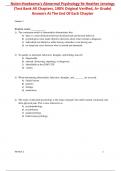Nolen-Hoeksema's Abnormal Psychology 9e Heather Jennings
(Test Bank All Chapters, 100% Original Verified, A+ Grade)
Answers At The End Of Each Chapter
Chapter 1
Student name:__________
1) The continuum model of abnormality demonstrates that
A) there is a clear distinction between dysfunctional and deviant behavior.
B) psychologists must make objective decisions about what warrants a diagnosis.
C) individuals are labeled as either having a disorder or not having one.
D) no sharp line exists between what is normal and abnormal.
2) To qualify as abnormal, behaviors, thoughts, and feelings must be
A) diagnosable.
B) unusual, distressing, impairing, or dangerous.
C) identifiable in the DSM-5-TR.
D) violent.
3) When determining abnormality, behaviors, thoughts, and________ are assessed.
A) family history
B) genetics
C) feelings
D) medication
4) The study of abnormal psychology is the study of people who suffer mental, emotional, and
often physical pain. This is also referred to as
A) psychopathology.
B) psychometry.
C) parapsychology.
D) behavioral psychology.
Version 1 1
,Chapter 1
5) Masha is a 27-year-old soccer mom who never misses her daughter's games. Her friends
argue that her behavior is embarrassing, and she is making a fool of herself when she
repeatedly yells and jumps to her feet. Masha insists that no one is paying attention to her
behavior and states, "It's a soccer game—people are expected to get excited!" What
determines whether Masha's behavior is normal?
A) her social status
B) gender differences
C) the context in which it is performed
D) individual differences
6) When an observer takes into account the context or circumstances surrounding someone's
behavior to determine whether they are normal or abnormal, it means that
A) the observer assesses the behavior based on their own biases and prejudices.
B) the observer considers the behavior normal if it seems appropriate for that particular
situation.
C) the observer judges the individual's personality based on the observer’s cognitive
abilities.
D) the observer's evaluation of the behavior lacks any theoretical grounding.
7) An advantage of cultural relativism is that
A) it does not impose the standards of one culture on judgments of abnormality.
B) there is a tendency to view all behaviors that are unusual, or deviant, as abnormal.
C) it allows those in power to label and silence minorities by labeling them as abnormal.
D) it does not adopt a continuum perspective of abnormal behavior; rather, it is an
either/or proposition.
8) Which criterion for abnormality implies that the presence of a disease is causing given
behavior?
A) deviance
B) unusualness
C) distress
D) mental illness
Version 1 2
,Chapter 1
9) Rachel teaches the second grade and suspects that two students in her class have behavioral
problems. Although she works fervently to keep the class running smoothly, the students'
behaviors continually disrupt the learning environment. When the two students blurt out the
answers before being called upon, push others in line, or constantly get out of their seats,
other students become distracted and irritated. According to which criterion will these
students' behaviors most likely be considered abnormal?
A) cultural relativism
B) mental illness
C) distress
D) gender relativism
10) What are "the four Ds" of abnormality?
A) distress, delusion, deviance, and derision
B) deviance, dysfunction, disorder, and danger
C) danger, disorder, delusion, and dysfunction
D) dysfunction, distress, deviance, and dangerousness
11) Theorists who argue that behaviors can only be abnormal relative to cultural norms are
proponents of
A) cultural hegemony.
B) cultural regeneration.
C) cultural imperialism.
D) cultural relativism.
12) Cultural relativists argue that
A) behaviors must be universally accepted to be considered normal.
B) context, and not culture, influences the evaluation of behaviors as abnormal.
C) the use of gender roles as a basis for assessing abnormal behaviors can be misleading.
D) no universal standards or rules exist for labeling behaviors as abnormal.
Version 1 3
, Chapter 1
13) ________ noted that, throughout history, societies have labeled individuals and groups
abnormal in order to justify controlling or silencing them.
A) Thomas Szasz
B) Samuel Cartwright
C) Clifford Beers
D) Johann Weyer
14) In some parts of the world, corporal punishment is a traditional child rearing practice,
whereas the practice is frowned upon in other places. In the context of abnormality, this is
reflective of
A) mental illness.
B) dysfunction.
C) distress.
D) cultural relativism.
15) In the context of cultural relativism, when slavery was active in the United States, enslaved
people who tried to escape bondage could be diagnosed with a mental disease that was said
to have caused them to
A) misunderstand their roles.
B) desire freedom from their enslavers.
C) refuse to work in the fields.
D) experience delusions of grandeur.
16) Which of the following is true of the distress criterion for abnormality?
A) The individual has no desire to be rid of the disruptive behavior.
B) The behavior must violate societal norms.
C) The individual must suffer as a result of the behavior.
D) The behavior must also meet the unusualness criterion.
17) Historically, which three types of theories have been used to define abnormal behavior?
A) sociological, religious, and psychological
B) biological, psychological, and sociological
C) biological, sociological, and supernatural
D) biological, supernatural, and psychological
Version 1 4





